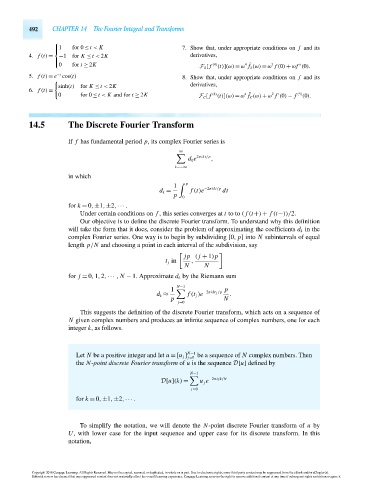Page 512 - Advanced engineering mathematics
P. 512
492 CHAPTER 14 The Fourier Integral and Transforms
⎧
⎪1 for 0 ≤ t < K 7. Show that, under appropriate conditions on f and its
⎨
4. f (t) = −1 for K ≤ t < 2K derivatives,
⎪
0 for t ≥ 2K F S [ f (4) (t)](ω) = ω ˆ f S (ω) = ω f (0) + ωf (0).
3
⎩
4
−t
5. f (t) = e cos(t) 8. Show that, under appropriate conditions on f and its
sinh(t) for K ≤ t < 2K derivatives,
6. f (t) =
0 for 0 ≤ t < K and for t ≥ 2K F C [ f (4) (t)](ω) = ω ˆ f C (ω) + ω f (0) − f (3) (0).
2
4
14.5 The Discrete Fourier Transform
If f has fundamental period p, its complex Fourier series is
∞
d k e 2πikt/p ,
k=−∞
in which
1 p
d k = f (t)e −2πikt/p dt
p 0
for k = 0,±1,±2,···.
Under certain conditions on f , this series converges at t to to ( f (t+) + f (t−))/2.
Our objective is to define the discrete Fourier transform. To understand why this definition
will take the form that it does, consider the problem of approximating the coefficients d k in the
complex Fourier series. One way is to begin by subdividing [0, p] into N subintervals of equal
length p/N and choosing a point in each interval of the subdivision, say
jp ( j + 1)p
t j in ,
N N
for j = 0,1,2,··· , N − 1. Approximate d k by the Riemann sum
N−1
1 p
d k ≈ f (t j )e −2πikt j /p .
p N
j=0
This suggests the definition of the discrete Fourier transform, which acts on a sequence of
N given complex numbers and produces an infinite sequence of complex numbers, one for each
integer k, as follows.
N−1
Let N be a positive integer and let u =[u j ] be a sequence of N complex numbers. Then
j=0
the N-point discrete Fourier transform of u is the sequence D[u] defined by
N−1
D[u](k) = u j e −2πijk/N
j=0
for k = 0,±1,±2,···.
To simplify the notation, we will denote the N-point discrete Fourier transform of u by
U, with lower case for the input sequence and upper case for its discrete transform. In this
notation,
Copyright 2010 Cengage Learning. All Rights Reserved. May not be copied, scanned, or duplicated, in whole or in part. Due to electronic rights, some third party content may be suppressed from the eBook and/or eChapter(s).
Editorial review has deemed that any suppressed content does not materially affect the overall learning experience. Cengage Learning reserves the right to remove additional content at any time if subsequent rights restrictions require it.
October 14, 2010 16:43 THM/NEIL Page-492 27410_14_ch14_p465-504

